Why Draw in Black and White?
I have often asked myself: “Why draw when you can paint?” And as someone who loves colors, it hasn’t always felt appealing to omit them. Still, one of the biggest things in my artistic development has been to find a connection to my childhood through black-and-white drawings.
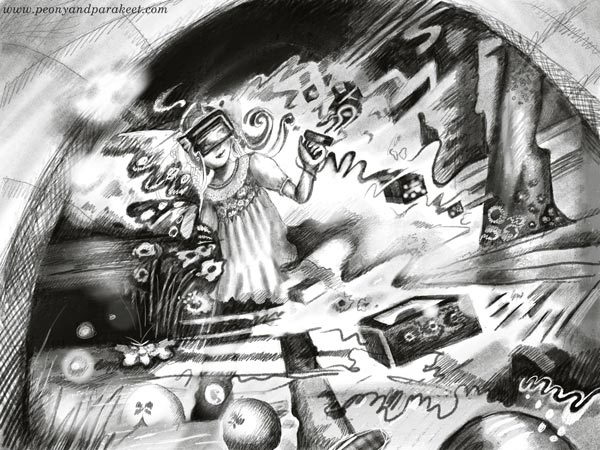
In this week’s blog post, I want to inspire you to draw things you love in black and white. If you want to practice ink drawing with me, see these courses: Animal Inkdom and Magical Inkdom!
My Way to Drawing in Black and White
It’s been over thirty years since my father’s death. He was quite distant, but I still vividly remember when he drew horses when I was a child. The horses were not noble and streamlined like in the picture books, but furry sympathetic characters. It was as if my dad really knew these animals.
So it was no wonder that when I participated in the Inktober drawing challenge in 2018, my drawing style borrowed a short hair-like line from my father. You can say that at that time, I fell in love with drawing. Nowadays, I still draw in black and white every time I want to visualize something through my thoughts. I now have an Apple Pen and Procreate, but I sometimes draw on paper as well.
See a quick 4-minute flip-through video about one of my sketchbooks!
See more pictures of the children’s book illustrations: The Beauty of Science – Illustrating a Children’s Book
Why Draw? – Move from One Idea to Many!
Drawing visualizes the invisible and makes us think deeper. First, the idea is wavering and could take any direction. But as the details increase, the big picture also grows. Therefore, it’s important for me to let the pen linger in small areas. I find pleasure in putting tiny pieces in place so that they are part of a bigger story.
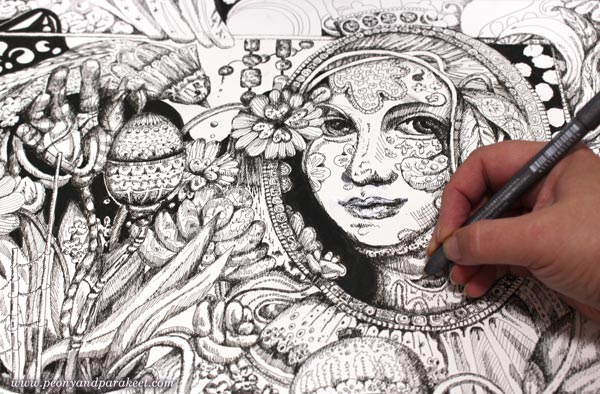
There are two good things about drawing with a thin black marker pen. First of all, the pen mark cannot be erased. You have to figure out how to make the wrong stroke a part of the drawing. It has often happened to me that the core of the picture was created while correcting a mistake. Another advantage is that when you don’t have to worry about colors, you can focus on shapes and patterns in peace. And of course, you can always color the drawing afterward, for example with colored pencils or watercolors.
Why Draw? – Connect Your Art with Your Origin!
I believe that anyone who has drawn for a while will develop an understanding of why they draw. I have a feeling that I was created to express things through ornaments. For me, an ornament is not just a picture, but a whole language. When drawing ornaments, I’m on the border between writing and illustrating, and feel that I am doing something important. As if I belong to those authors to whom poetry appears as pictures.
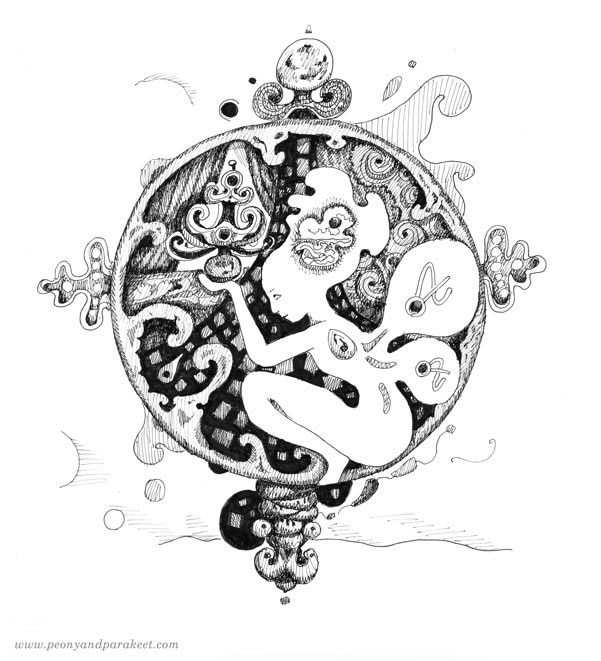
It’s confusing, but this connection between drawing and writing seems to have arisen in me when my father drew a horse. Of course, I didn’t know how to break it down like that as a child, but I now think of my father’s horses as ornaments that summarized the origin of our family. It wasn’t the most elegant possible, but I still wanted to give it wings. Nowadays, every time I draw, I feel close to where I am coming from. I hope that by drawing you too will find wings for your origin!
What would you like to draw? Leave a comment!
Wonderland Art – Inspiration from Alice in Wonderland
Last fall, I was asked to participate in a small gallery exhibition called Kaninkolo (Rabbit Hole). I thought that the name was a funny reference to the Alice in Wonderland book and an opportunity to create fantastic wonderland art. I had previously covered the wonderland theme by drawing for the Magical Inkdom course. It was fun to see how the theme would lend itself to my painting style, which is much more abstract.
Wonderland Rises From the Dark

For me, wonderland art calls for dark colors. I’ve seen Tim Burton’s movie Alice in Wonderland and I think it has some wonderfully gloomy scenes. I would really like to paint dark paintings because exciting things can happen in the dark. However, I try to curb this desire, because Finnish homes are light and light paintings sell better!

But now I got permission from myself to paint one dark painting, in which I also rejoiced with colors.
New is a Wonderland
I started with confidence, but at some point in the frenzy of painting, I stopped: “Could I paint so boldly? Should I tone down a bit?” But then the painting replied: “Päivi, don’t be afraid in wonderland!”
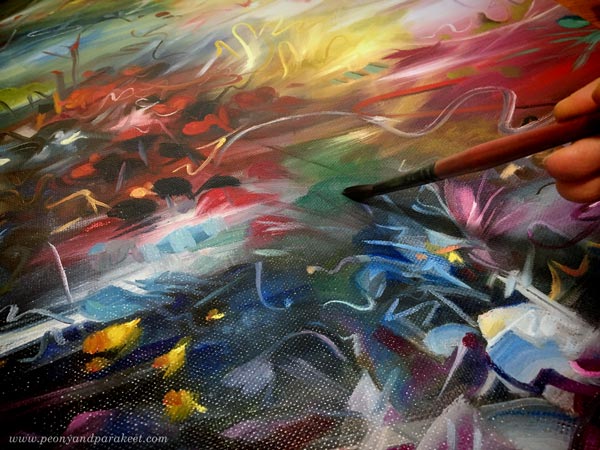
And yes, whenever we are on the verge of something new, we are a bit like Alice in Wonderland. Then you just have to keep experimenting and painting. I admire brave people and I would like to paint with courage. It’s not always possible to do that, but I’m going to continue to let loose from time to time!
Wonderland Art – Queen, Alice, and Others
This “Don’t Be Afraid in Wonderland” piece was really fun to paint. Among the characters in the book, my favorite is the Queen of Hearts. Of course, Mad Hatter also had to be painted.

I also included Cheshire Cat, as well as the twins Tweedledee and Tweedledum.

In this painting, Alice is a flying flower!
Wonderland Art – Wheel of Fortune
When I started building the Magical Inkdom course in 2019, one of my first drawings was this Wheel of Fortune.
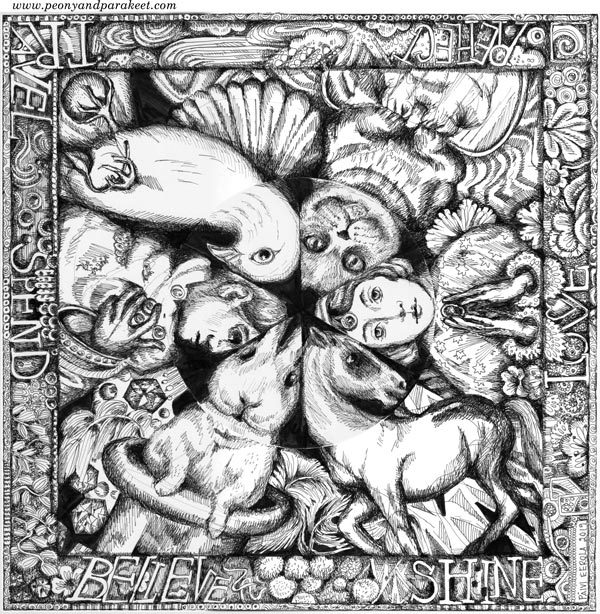
When drawing all the details, I thought about how I would divide the lessons. I got the idea to make a separate central circle for the drawing, which can be rotated and thus change the heads and outfits of the characters. You can see the wheel at the end of this video:
Drawing a gameboard with a wheel helped me to come out with the idea of playing cards and a bag for storing them.
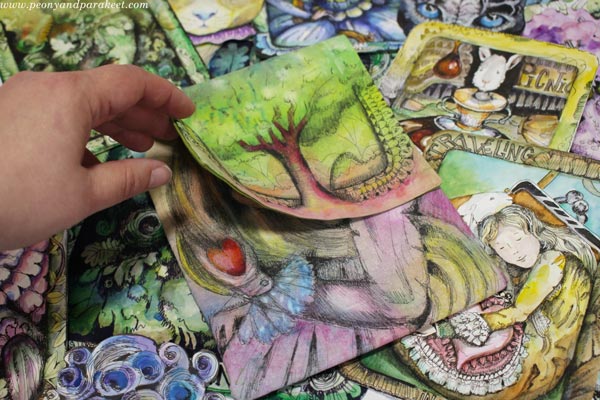
So when I went more abstract and thought about the concept of the wonderland, it fed ideas for several lessons.
Moving from Wonderland Characters to Wonderland Mood
Lately, I’ve been thinking a lot about the differences between representational and abstract and what can be expressed with abstract imagery. For example, could I paint an abstract outdoor tea party?

I saw the arbor and the delicate porcelain cups in my mind, but could I detach the motifs from the cups and fly to the place as a magician who removes the excess realism?
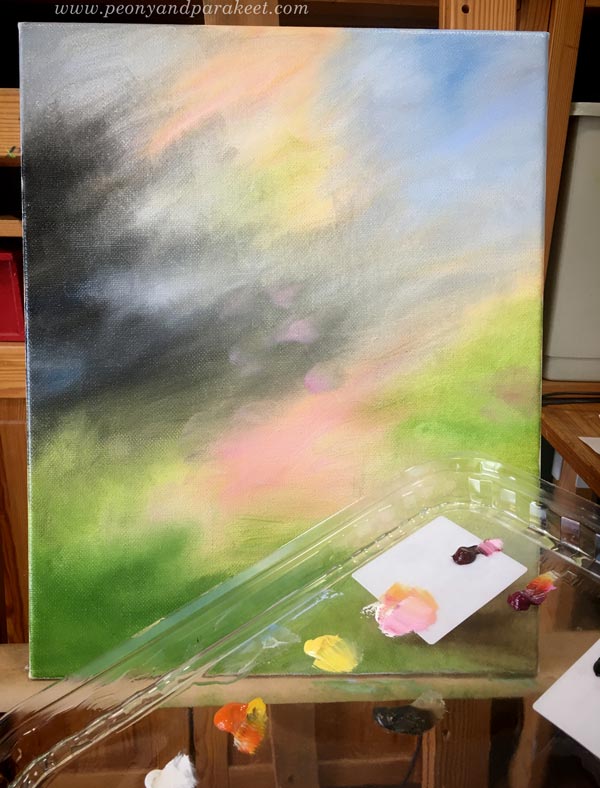
When painting abstract, I try to change the original idea to a mood, and then paint the mood. My mind is then in a 3-dimensional dynamic space rather than trying to maintain a 2-dimensional static image.

I think this tea party themed little painting turned out pretty well!
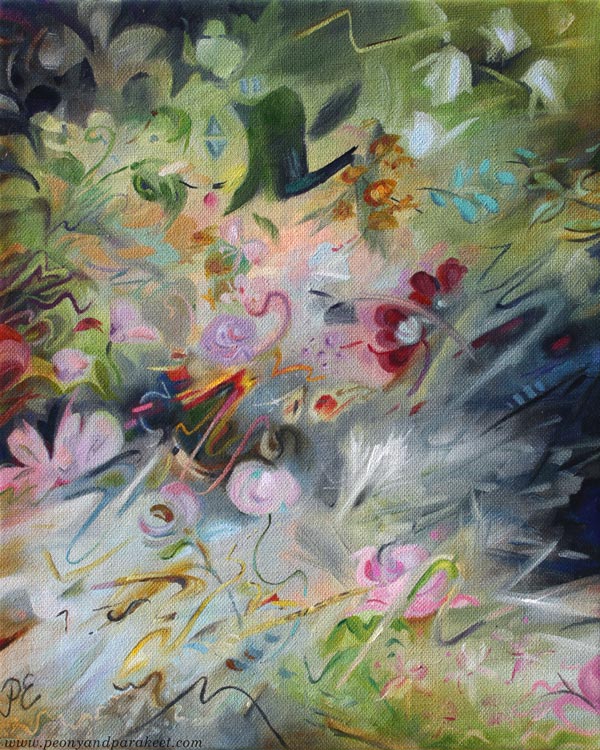
Art is a wonderland where you can do anything!
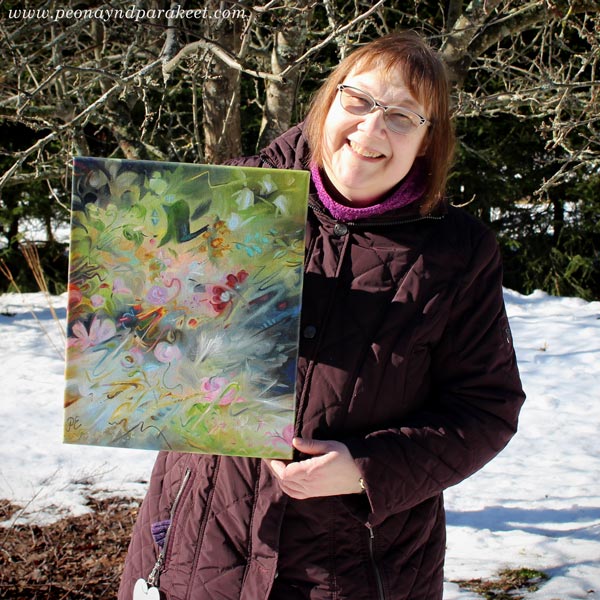
Here you can see the size of the painting better: 40 x 32 cm, about 15 3/4 and 12 1/2 inches.
Does Drawing Help for Loosening Up in Expression?
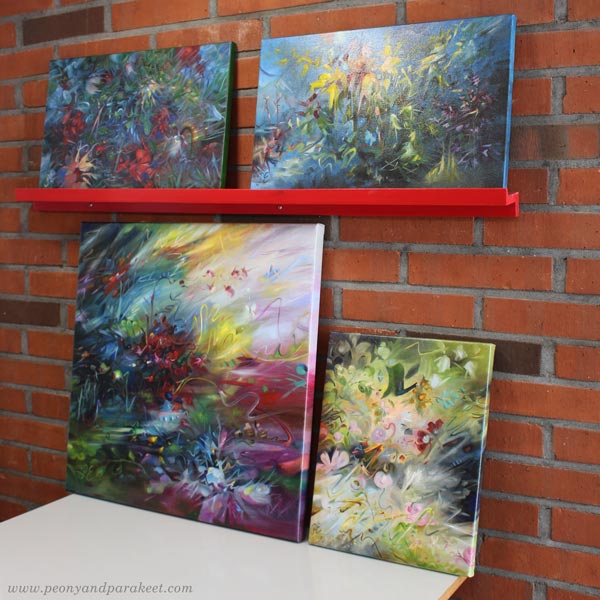
I have wondered if my abstract painting style would ever have been found without drawing figuratively. But I don’t think that would have happened. To become looser, it has been important to learn how reality works and how to express it with shapes.
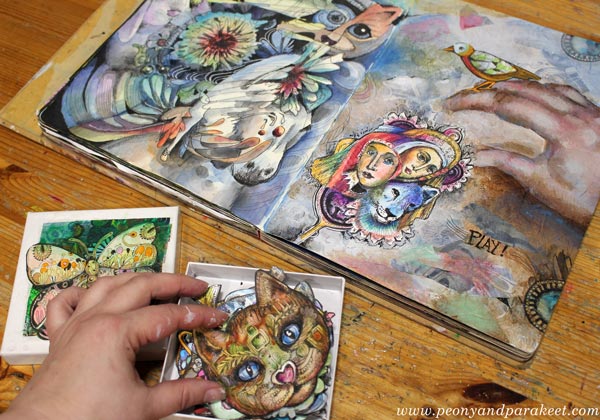
That’s why I’m really happy that my way to wonderland has been through a bend. And even that kind of a bend that I can share with the rest of you through the Magical Inkdom course among others.
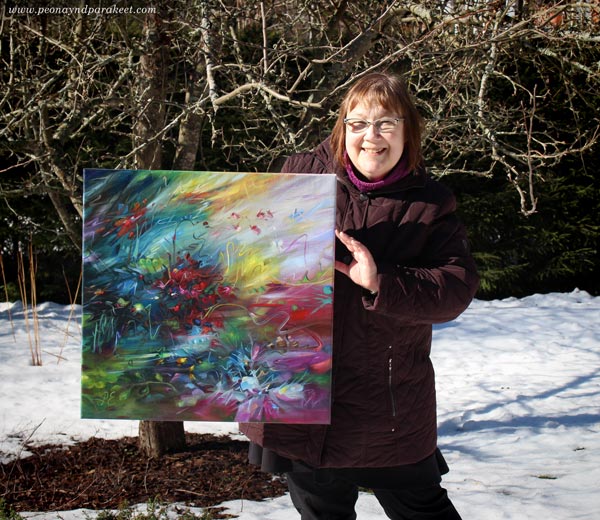
April 8-27, 2023, Kaninkolo group exhibition at Gallery Art Frida, Korkeavuorenkatu 25, Helsinki
Does Alice in Wonderland inspire you?
Drawing Inspiration – What I learned from Inspirational Drawing
This week, I have some drawing inspiration for you. Let’s celebrate our living line!
Recently, I heard the term “transition” and it resonated strongly. After receiving the grant from the Finnish Cultural Foundation, I have thought about my artistic career forward and at the same time also backward. I’ve noticed that it’s hard to think about the future without thinking about the past. I thought I’d write a few blog posts this spring about how I’ve grown my artistic skills by building courses.
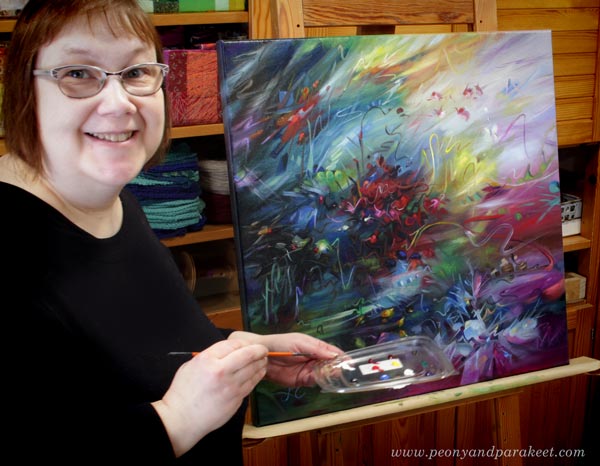
First, I want to talk about a course that formed the basis not only for everything I teach but also for how I paint today.
From Dots and Circles to a Living Line
Wassily Kandinsky (1866-1944) said “Everything starts from a dot.” On the same topic, Paul Klee (1879-1940) stated: “A line is a dot that went for a walk.” I think that when a person feels the call of fine art, he is at a point where he wants to get to know himself, to walk inward. I first went on a small tour only: I drew circles.
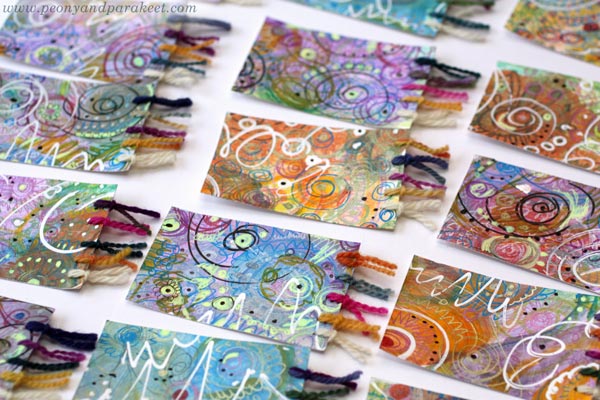
When I finally understood that I could open the circle and boldly move forward, a new world opened up. I saw my living line pulsating strongly. I felt I could draw anything and didn’t have to “know how to draw” to draw.
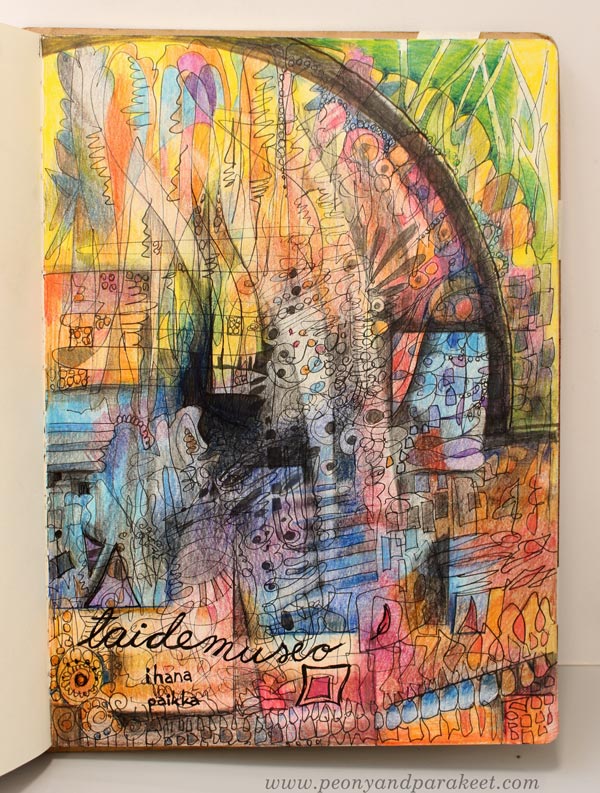
Fall in Love with Your Line
It became my calling to help people who are stuck and going around in circles move forward. In 2015, I first made a trial course for Finns called “Inspiroidu piirtämisestä” (Get inspired by drawing) and learned how to make an online course and clarify my points. Then, based on the Finnish course, I made an English version called Inspirational Drawing. When time passed and I got more experience, I made the same course a third time. In 2017, the most comprehensive version Inspirational Drawing 2.0 was born, which is also in my current course selection.
Inspirational Drawing is based on getting to know your own line. You don’t immediately remove your hand from the paper, but let the line travel a longer distance. This technique is commonly called “contour drawing”, but in my version, you don’t copy what is presented, but walk with your line and let the landscapes open up to the unpredictable.
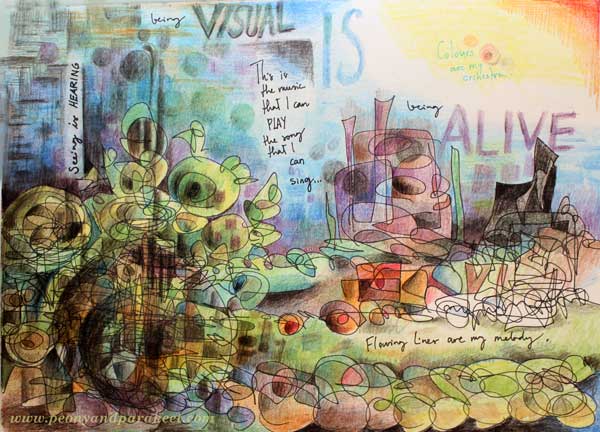
Your line is as unique as your signature. The most motivating thing in art-making is to fall in love with your line. When you want to repeatedly see your line and cherish it, it will also reveal its hidden potential. With your line, you can go much deeper in drawing inspiration and feel much freer than if you cut and compose collages from magazines or use stencils or stamps.
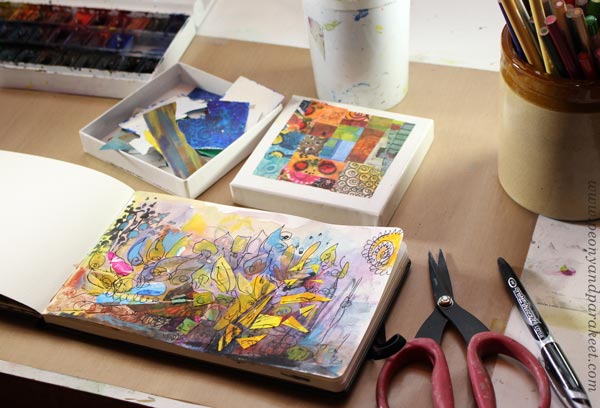
Drawing Inspiration
Inspiring pictures are also at the core of Inspirational Drawing. It’s natural for a creative person to collect pictures in one way or another, and drawing is a wonderful way to spend time with them. In the course, you will be guided to use the pictures you have chosen in drawing so that the pictures are not copied in the traditional style. To fuel free drawing, ideas are extracted from them. I still use this kind of inspiring effect of images in my painting process.
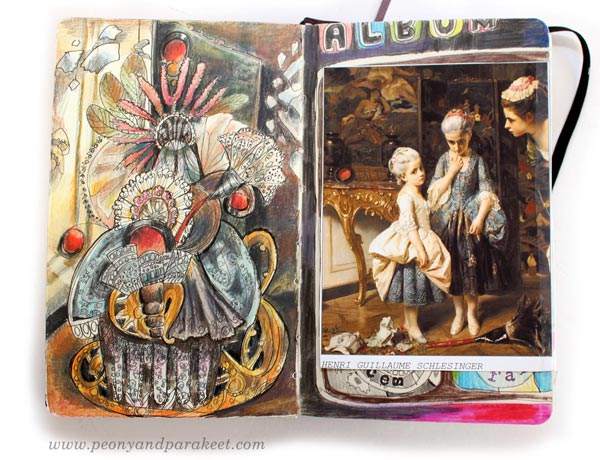
When moving from a point and closed shapes to an open, free-roaming line, inspiration has been a keyword anyway. With inspiration comes courage. It’s wonderful to draw when inspired. And it’s wonderful to inspire others with your own creative outcome.
Start Drawing!
Inspirational Drawing is now for sale this weekend, from March 15-19, 2023 (midnight PDT).
Inspirational Drawing – Get 20 % OFF – buy here!
Art Supplies and Emotions
This week, we ponder what kind of feelings and emotions our art supplies raise in us.
Do you remember these small paintings from a few weeks ago?
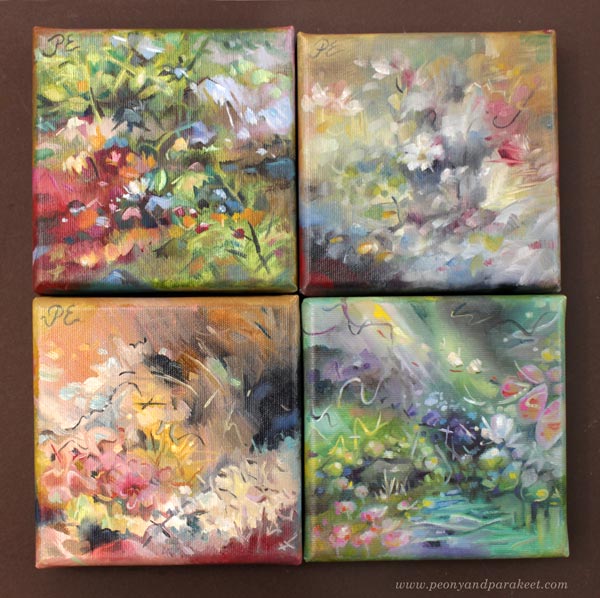
I now got the fourth one finished, and I couldn’t resist taking a photo of them together. These are only 6 by 6 inches, and the small size enables me to study a style or an idea before making a bigger painting. So, in a way, these are like pages in an art journal – small art that is delightful to create and look at but that doesn’t fill a wall. It’s the first time I feel I can create quick experiments directly in oils. And this brings us to the topic of art supplies.
Crayons, Inks, and All the Possibilities
I have now painted on canvas in oil for over two years, and most of the other art supplies don’t inspire me so much anymore. I have all kinds of crayons, inks, and paint tubes that were purchased in a different mindset many years ago.

Back then, a new supply meant a new beginning. Purchasing a box of crayons meant that I still believed in myself – that there was still hope that I will become an artist. See a video of me working with crayons – a blog post from 2017.

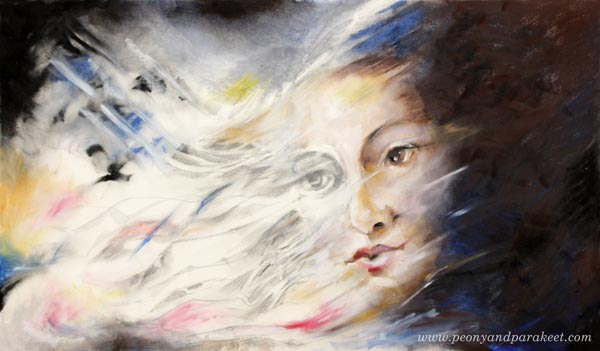
I like many of the pieces that I created back then, but now when I look at those boxes of crayons, the magic has gone away. All I can hear is the calling of my beloved oil paints.
There are two exceptions though.
Colored Pencils Are the Easiest Art Supplies
Colored Pencils bring me back to my childhood when I was drawing with my elder sisters, admiring what they did with them. For me, colored pencils were not just pencils, but dolls that had names. It was sad to see a doll that I loved get shortened and then finally thrown away!
Compared to oil paints, colored pencils have an advantage. There’s no preparation involved. When I paint with oils, I need to build the palette, clean the caps, select the brushes, protect the tabletop, etc. But with colored pencils, I can just grab a piece of paper or open another page in a journal and start coloring freely. When I am tired but still want to create something, it’s really nice.

I have also liked to maintain my illustration skills, and colored pencils are great for that too. For example, see the newest course Doll World!
Watercolors Are a Great Teacher
I am also emotionally connected with my watercolor set. Even if I haven’t used it much lately, I feel that painting in a watercolor set my style. Many techniques that I use in oil were learned when I was painting in watercolor, for example, negative painting and building an image layer by layer.
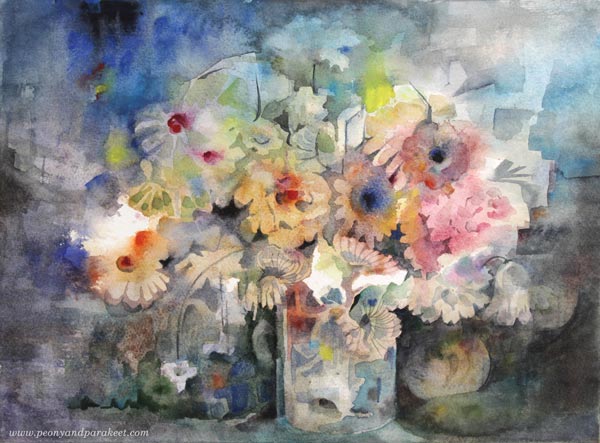
I also learned a lot about pigments and their behavior back then. It was a good learning experience to paint many pieces in a row.
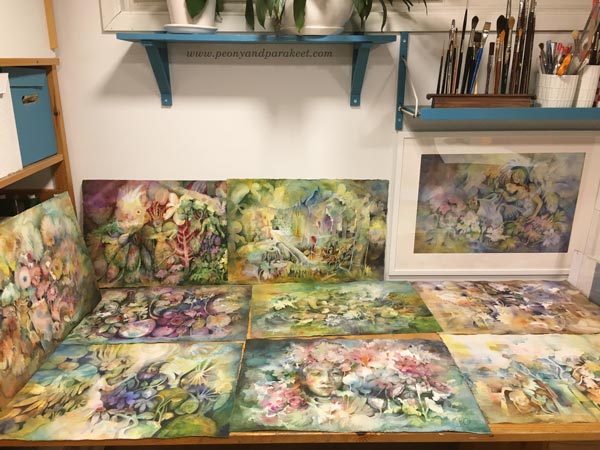
I have several courses on watercolor, for example, Magical Forest for fairies and Floral Fantasies for floral still lives!
What about all those inks, crayons, and such, did I learn anything from them? Yes, of course, but when I look back, it feels like when I started to focus more on one media instead of mixed media, I also took a big leap forward in skills. My art went forward when I no longer tried to find a solution by changing the media but by growing the skill. I was also able to get a more emotional connection with the supplies and somehow that feels very important to me.
Oils vs. Acrylics as Art Supplies
Before oils, I painted in acrylics for some time. They are more practical. They don’t smell like wet oil does. The painting mediums have less odor too. They dry fast so painting is much faster, no need to wait for days before adding a new layer or making the finishing touches. Acrylics don’t require a similar kind of knowledge of pigments and painting mediums as oils do. In oils, you have to be careful with some pigments and the use of mediums because they may cause crackling.
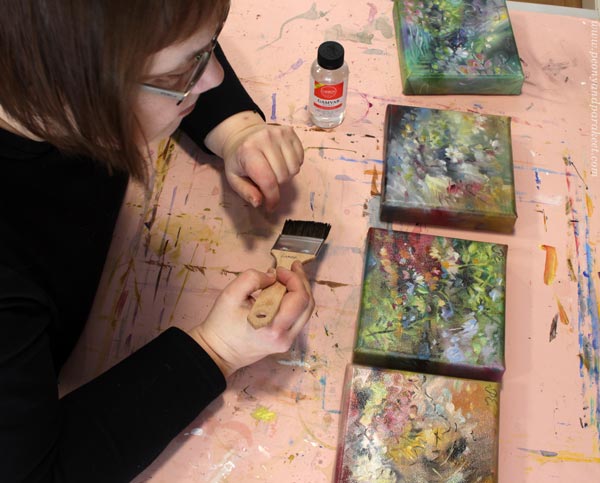
Despite all that worry, when I open my box of oil tubes, I feel different than if I pick acrylics.
The Emotions I Get When Painting in Oil
The oil paints connect me to the past. They take me to the time before I was even born.
Within seconds, I travel back to the beginning of the 20th century, meet the early abstract painters and impressionists, then continue my journey to the 19th century and meet pre-raphaelites, and move from them to those who wanted to capture the realism, and to those who were more romantics. Then again, within seconds, I go to the 18th century and admire all the floral still lives and women in beautiful dresses.
And at best, I continue the journey to the 17th and 16th centuries and see big paintings full of details. Then I also meet the masters that had the patience to make really thin layers and wait for each to dry before adding a new one.
This time traveling enables me to meet long-time friends like Wassily Kandinsky, Peter Paul Rubens, and Leonardo da Vinci and if I do some browsing before I start painting, I always find a new one that I want to meet and learn from.
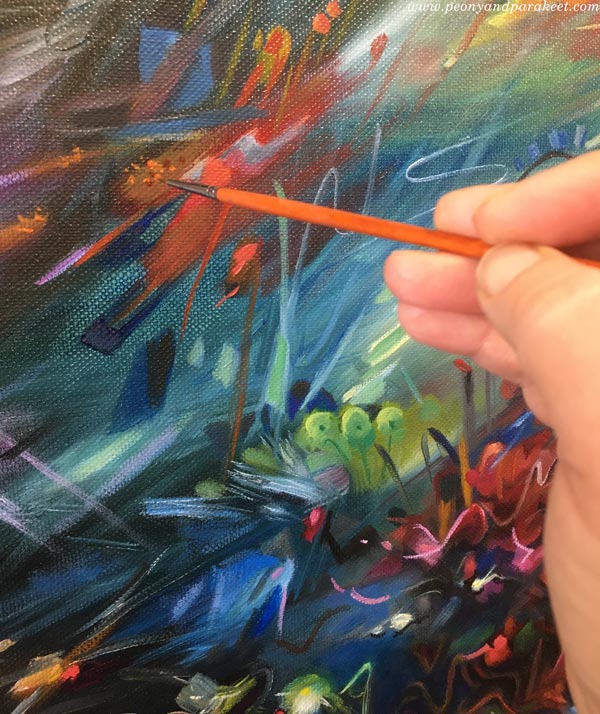
And now when I am painting for the upcoming Albert Edelfelt -themed exhibition, I also learn from him.
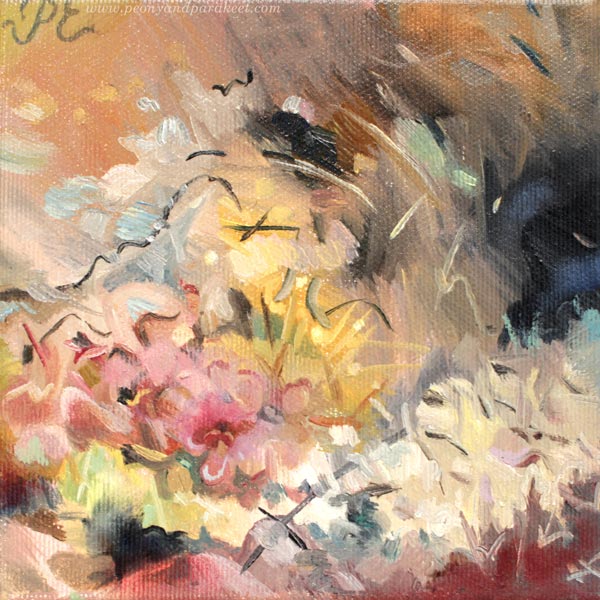
There are many great artists today, but I feel that tracing what you love back to history is essential to artistic growth. I also get satisfaction from knowing that I belong to the chain of generations. Artists from the past, still live through me.
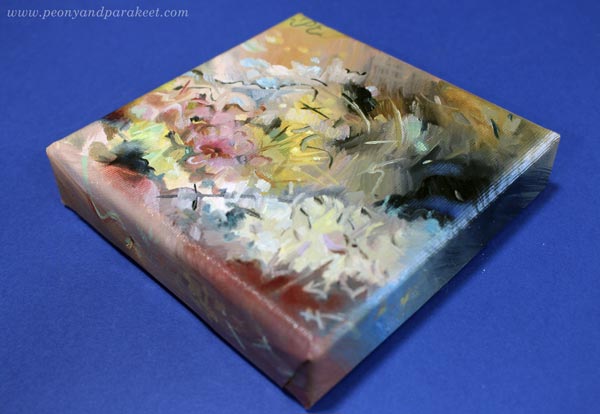
Paintings In Progress
I have been painting quite a lot recently, and there are many more paintings in the queue.

These are in-progress pictures! I will show you the finished ones in the near future!
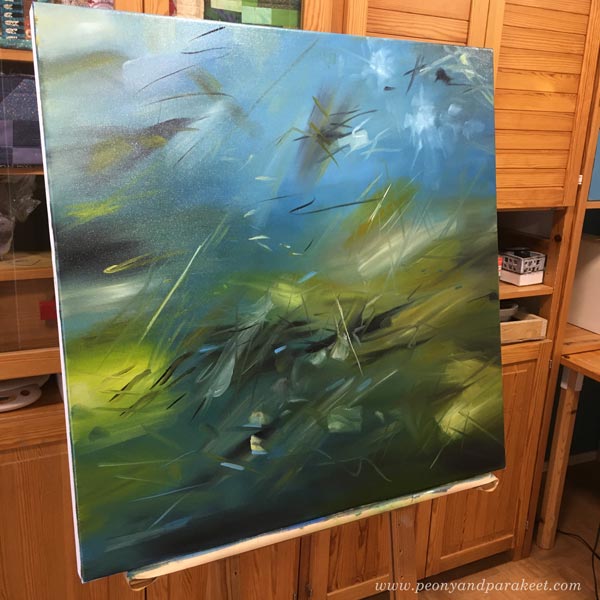
I usually reserve a whole day for painting and try not to do anything else at the same time. If you want to follow a painting day, look for my Instagram stories where I usually post in-progress photos when I am testing the composition and such.
What are Your Favorite Art Supplies?
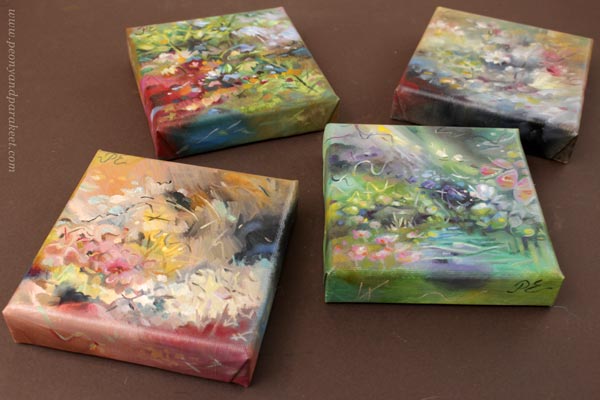
Tell us what are your favorite art supplies at the moment!
It would also be interesting to know which supplies raise emotions in you.